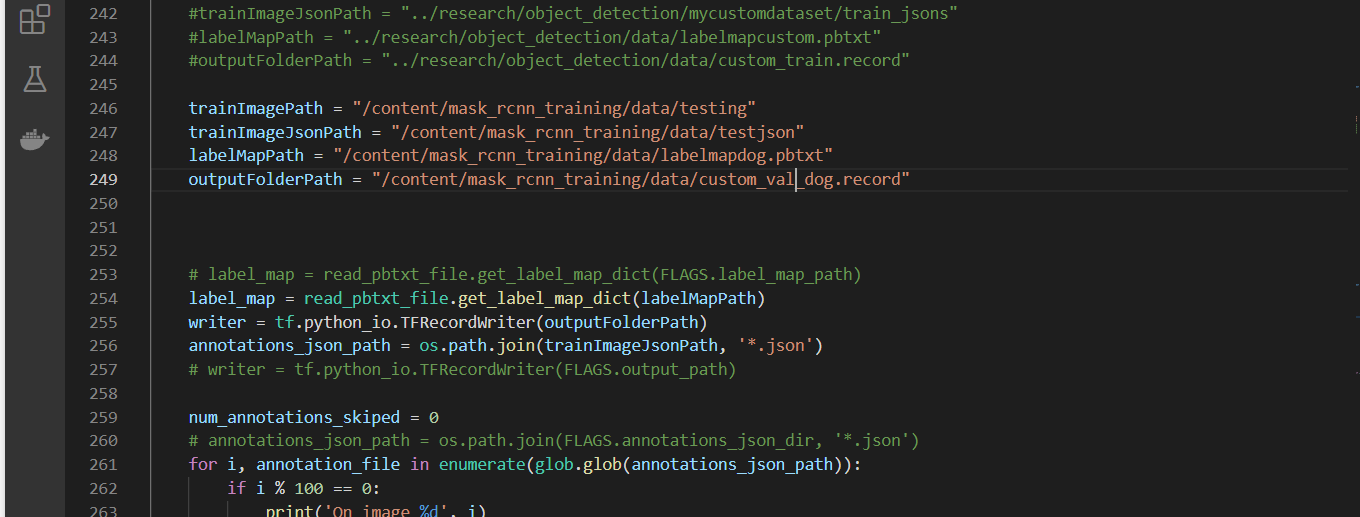Name: kishor G
Email: kishorbrindha18@gmail.com
In June 2017, Google opened the TensorFlow Object Detection API. This project uses TensorFlow to implement most of the deep learning target detection frameworks, including MaskRCNN in reality.
https://github.com/tensorflow/models/tree/master/research/object_detection
https://github.com/tensorflow/models/tree/v1.13.0
MASK RCNN Model link :-
http://download.tensorflow.org/models/object_detection/mask_rcnn_inception_v2_coco_2018_01_28.tar.gz
Data Annotation:
In data annotation, we will be using Labelme Tool
Download the Tool from the given Link:-
https://github.com/wkentaro/labelme
Installation of Labelme:
conda create --name=labelme python=3.6
conda activate labelme
# conda install -c conda-forge pyside2
# conda install pyqt
# pip install pyqt5 # pyqt5 can be installed via pip on python3
pip install labelme
labelme
Then the interface of labelme will popup.
Click on Open Dir and select the folder where your test images or train images are. Then start labelling all images in the dataset.
The selected image is loaded in the Labelme Interface.
Click on Start Drawing Polygons.
Create the Polygon Box and write the Label name corresponding to the image
Click on the Save button and a corresponding JSON file will be saved in the directory with the image.
NEXT
Split the dataset into 80:20 ratio for train and validation(use splitfolders Library)
Create a new folder named Data in your local system. This is where we will be
keeping our own trainingdata,testdata,trainjson(annotated),testjson(annotated),label
map.pbtxt,read_pbtxt,read_pbtxt_file,setup.py,string_int_label_map_pb2 and
create_tf_records.
create_tf_records:
** As we are using TFOD framework for training maskrcnn you have to convert all the trainjson and testjson annotated images to tf_records. So we use create_tf_record.py file and we will perform the conversion.
read_pbtxt ,read_pbtxt_file,string_int_label_map_pb2 are helper file for create_tf_records.py file
Setup.py:
** As we are following modular coding approach we create a setup.py file and install it to make object_detection as local package.
labelmap.pbtxt: **
** The label map tells the trainer what each object is by defining a mapping of class names to class ID numbers. Use a text editor to create a new file and save it as labelmap.pbtxt
Replace the names of the classes with your class names.
This is a sample one.
Zip the data folder and keep it ready we will be using this folder later.
Colab_file_link : https://colab.research.google.com/drive/1NmyMeMqmGT2uDHIPjh6WnC6MYK4XHY4e?usp=sharing
GOOGLE_COLAB_SETUP:
-
Step1: Mount your Google drive
-
Step 2: Download the tensorflow repository
-
Step 3: Download the mask rcnn pretrained model and unzip it
-
Step 4: Install necessary requirements
-
Step 5: upload data and other requirements in zip file format(data.zip)
-
step 6: convert .json to .tf-records and create tf-records **
Changes in create_tf_records.py for both train and test Data:
- trainImagePath(index-246)
- trainImagePath(json)
- labelMapPath
- outputFolderPath(index-249)
Change the path for both training and test data save and
close the file.
Train data:
Test data:
-
Step 7: move the custom_train_dog.record ,custom_val_dog.record and setup.py to research folder. And install setup.py.
-
Step 8: create a folder named training in research folder and move frozen_inference_graph.pb from mask_rcnn(pretrained_model) folder to training folder,move labelmap.pbtxt from data folder to training folder. And copy the file named mask_rcnn_inception_v2_coco.config from the given path /content/mask_rcnn_training/models/research/object_detection/samples/configs/mask_rcnn_inception_v2_coco.config and paste it in training folder
Step 9: changes to be made in mask_rcnn_inception_v2_coco.config
Changes:
-
10->num_classes-1
-
127->fine_tune_checkpoint-"mask_rcnn/model.ckpt"
-
133->num_steps- 200
-
142->input_path-"custom_train_dog.record"
-
144->label_map_path-"training/labelmapdog.pbtxt"
-
158->input path-"custom_val_dog.record".
-
160->label_map_path-"training/labelmapdog.pbtxt"
Make the above changes save and close the file
** All the red box cells contain the path that I am using. It may change based on your preferences.
Step 10: copy train.py from object_detection/legacy and paste the file in research folder and start the training
-
Start the training
-
Command for training: !python train.py --logtostderr --train_dir=training/ --pipeline_config_path=training/mask_rcnn_inception_v2_coco.config
Step 11: ckpt to pb conversion
-
See the training/model.ckpt and give the latest ckpt number in the command for the conversion.
-
Command for conversion: !python export_inference_graph.py --input_type image_tensor --pipeline_config_path training/mask_rcnn_inception_v2_coco.config --trained_checkpoint_prefix training/model.ckpt-200 --output_directory frozen_inference_graph
-
Training has completed sucCessfully and model has been saved in research/frozen_inference_graph/ utilize that model for infErencing.
Now we can use this frozen_inference_graph.pb model to predict.
Now lets predict : -
-
Step 1: Necessary imports
-
Step 2: Model preparation
Changes:
-
PATH_TO_FROZEN_GRAPH
-
PATH_TO_LABLES
-
Step 4: Load a (frozen) Tensorflow model into memory.
-
Step 5: Loading label map.
-
Step 6: Helper code.
-
Step 7: upload test images and unzip it (test_image.zip).
-
Step 8:Detection
Test data must be named as image1,image2,image3…..etc. This is done to access the images easily.
Only you have to change the for loop if 5 images then range(1,6) if 20 image range(1,21) etc. And change the PATH_TO_IMAGES_DIR relative to your path were the test images is available.
Now execute all the remaining cells of the notebook and your test pictures will be displayed at the last cell.
RESULT:
CONCLUSION:
I have trained the maskrcnn model with dog dataset for only 600 steps and I have got a pretty good result. If you increase the steps and dataset size your accuracy will increase.** Data argumentation and data annotation must be done very carefully.**


















